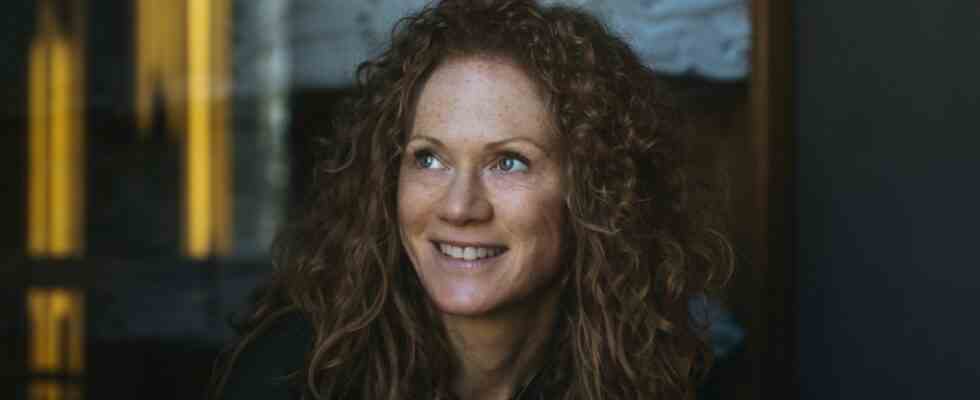In the eyes of her publisher, Alexa Hennig von Lange has found a “treasure”. The author, who was assigned to pop literature in the 1990s, but has been writing mainly light entertainment and young adult literature for some time, was able to draw on her experience for her new novel. At the age of over ninety, her grandmother documented her own life story between 1908 and 1965 on more than 130 cassettes.
Hennig von Lange has used this material to create a trilogy of novels, the first volume of which, entitled “The Checkered Girls”, has now been published. He describes the experiences of a young woman who, like the author’s grandmother, worked as a teacher at a children’s sanatorium and as head of an educational institution for young girls in the 1930s.
As Hennig von Lange reports in the epilogue, when she listened to the cassettes, she was “disturbed” by what her grandmother didn’t say: “She described pupils, character traits, conversations, inauguration ceremonies, the vegetation and the visits of high officials, but not that the synagogue was burning a few minutes’ walk away.”
It would have been appealing if the author had taken this omission, this silence, seriously and drawn conclusions from it for the narrative form of her novel. In this way it might have been possible to present what the author found in her grandmother’s notes – a biography marked by contradictions. Hennig von Lange opted for the opposite. She filled in the gaps in the narrative with a morally saturated history lesson in the form of a literary account of her experiences.
All major events of the late 1920s and 1930s are described from the perspective of the protagonist Klara, who, just like Hennig von Lange’s grandmother, absorbs her memories in old age and alternates between current reflections, critical self-questioning and the description of the past jumps here.
In 1929, young Klara was just as “reverential” spectator of the bicentenary for the “great philosopher Moses Mendelssohn” in Dessau’s Jewish synagogue as she was horrified nine years later when she watched the fire and looting of the church. She visits the “Degenerate Art” exhibition, where the masses of spectators enjoy “defaming, betraying and humiliating fellow human beings” while she herself perceives the reviled images as a “rain of colored gems” that only so ” “creative power” sparkle.
To be on the safe side, Klara’s perspective always conveys its interpretation
On the day after the Reich pogrom night, she “trembled” through the streets of Goslar, where people were “tired of seeing their neighbors’ suffering”. And when the radio reported about the book burning, Klara and her friend Susanne expressed their shock at the “terrible mental illness” that this “brainless” act revealed. Klara’s perspective always conveys the interpretation of the events at the same time as they are told. Here the National Socialist “monsters” and the angry mob, there the horrified young women.
The life story of the main character should, according to the author, raise “moral questions”. But the world that Hennig von Lange draws is too template-like to allow real contradictions to become visible. In order to save the educational institution from being closed, Klara cooperates with the National Socialist rulers. Klara experiences the officials who visit the home as “cold” and brutal. At no point in the novel is her integrity in question.
However, the story becomes completely schematic and clichéd through an additional fictional plot line, which the author of the life story lent to her grandmother: When the Jewish orphan Tolla was taken to the sanatorium at the age of just a few months, Klara passed the girl off as her own daughter , in order to protect it from access by the regime. According to the author, Tolla stands for the “loss of innocence” and the “pain” that arises when a “whole society turns against humanity”.
The complexity of individual biographies shrinks to sentimental symbolism
When characters become allegories of guilt or innocence and embody principles, the complexity of historical events and the contradictions of individual biographies are reduced to maudlin symbolism. With Hennig von Lange, the political is reduced to simple opposites and emotional conflicts. Linguistically, the novel is characterized in many places by an exuberant use of adjectives and crooked images: “The warm wind flowed over her cheeks as she disappeared into the cool pine forest and the bike jumped over the small potholes.”
Kitsch, as Adorno put it, “parodies catharsis”. What is meant by this is that a need for harmony and sentimentality is served by resolving conflicts in such a way that ambiguities and tensions no longer remain. Cheesy lyrics don’t put themselves or their audience at risk. They confirm what you already knew and believed.
It seems that Hennig von Lange smoothed out and simplified many things in her attempt to come to terms with the contradictions in her grandmother’s life and to start a “conversation” with her. Perhaps in this case it would have been better to rely a little less on one’s own imagination and one’s own ideas of good and evil than on the fact that the best stories are written by life itself.
Alexa Hennig von Lange: The checkered girls. Novel. Dumont, Cologne 2022. 368 pages, 22 euros.

